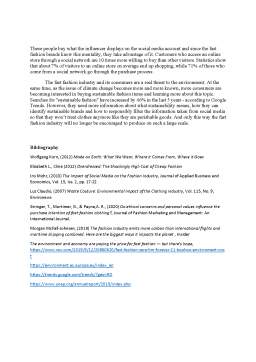Extras din referat
It has become apparent that climate change is a major issue that humanity has to face in the 21st century and is no longer something that we can pass on to future generations.
Scientifical studies in the last decades proved the anthropogenic activities that cause climate change are sped up deforestation, pollution, and the burning of increasing amounts of fossil fuels, resulting in changes in the concentration of greenhouse gases in the atmosphere and emissions of a variety of aerosols. Increasing the proportion of carbon dioxide in the atmosphere leads to an increase in the greenhouse effect. Research shows that in Europe, carbon dioxide is 80% responsible for the formation of the greenhouse effect, and its share in the atmosphere has increased by 40% in the last 200 years. Various industries use coal, oil, and natural gas.
Studies have shown that the clothing and textile industry is one of the most polluting in the world, with many experts claiming that it is in second place, after the oil industry. Nowadays, sustainable fashion is a topic that is being addressed more frequently because people are becoming aware of the impact that the clothing industry has on the environment.
However, the opposite of sustainable fashion, namely ‘fast fashion’, has dominated and reshaped the fashion industry since the 1990s and has been an important factor in the devastating impact on the environment because of huge greenhouse gas emissions. The ‘fast fashion’ term was first used in the early 1990s to describe the Zara business model and has now come to dominate much of the industry. We can describe this trend as cheap clothes often inspired by the creations of luxury fashion brands, fast production, and accelerated sales. If before, the trends were dictated by fashion shows that usually took place twice a year, now not only do we have presentations and launches as often as four to five times a year, but big retailers like TopShop, Primark, Inditex, H&M Group, Forever 21 can turn an idea or a current trend into reality in a few weeks.
Fast fashion is based primarily on the production of clothes as cheap as possible, from lower-quality materials, obtained by polluting methods, and not at all safe for consumers, but especially for the environment. Clothes are mostly made of different types of materials, often mixtures of different fabrics, many of them synthetic. Cotton is found in 40% of all clothing produced globally, while nylon and polyester are found in 70% of clothing. Both of the latter materials are extremely polluting and are often not obtained from the recycling of other materials.
Even though cotton is a natural material, industrialization and the enormous quantities in which it has come to be cultivated have turned it into a material with potential pollution. Cotton is a large, water-hungry plant and 2.6% of the world's water is used for cotton plantations. The manufacture of a single T-shirt requires more than 2000 liters of water. Although only 2.4% of the agricultural area of the Earth is covered with cotton plants, they consume almost 10% of all chemicals used worldwide in the agricultural industry and no less than 25% of all pesticides. An environmental catastrophe coupled with the fashion industry occurred in the 1960s when the Soviet Union redirected two rivers that fed the Aral Sea to maintain cotton plantations in areas now known as Kazakhstan and Uzbekistan, resulting in an ecological catastrophe: the Aral Sea, the fourth largest lake on earth, has shrunk by 90%.
Bibliografie
Wolfgang Korn, (2012) Made on Earth: What We Wear, Where it Comes From, Where it Goes
Elizabeth L., Cline (2012) Overdressed: The Shockingly High Cost of Cheap Fashion
Iris Mohr, (2013) The Impact of Social Media on the Fashion Industry, Journal of Applied Business and Economics, Vol. 15, Iss. 2, pp. 17-22
Luz Claudio, (2007) Waste Couture: Environmental Impact of the Clothing Industry, Vol. 115, No. 9, Environews
Stringer, T., Mortimer, G., & Payne,A. R., (2020) Do ethical concerns and personal values influence the purchase intention of fast-fashion clothing?, Journal of Fashion Marketing and Management: An International Journal.
Morgan McFall-Johnsen, (2019) The fashion industry emits more carbon than international flights and maritime shipping combined. Here are the biggest ways it impacts the planet., Insider
The environment and economy are paying the price for fast fashion — but there’s hope, https://www.vox.com/2019/9/12/20860620/fast-fashion-zara-hm-forever-21-boohoo-environment-cost
https://environment.ec.europa.eu/index_en
https://trends.google.com/trends/?geo=RO
https://www.unep.org/annualreport/2019/index.php
Preview document
Conținut arhivă zip
- The influence of the fashion industry on the environment.docx








